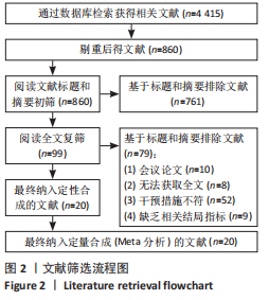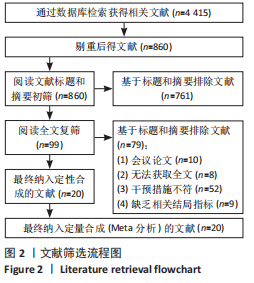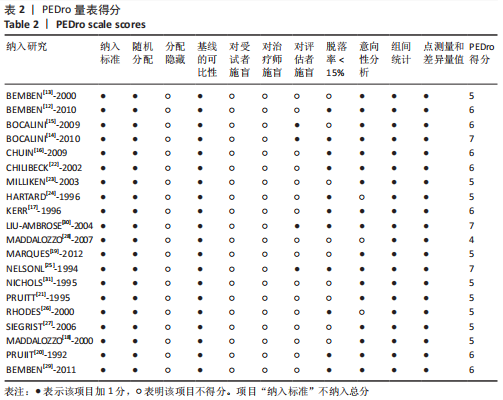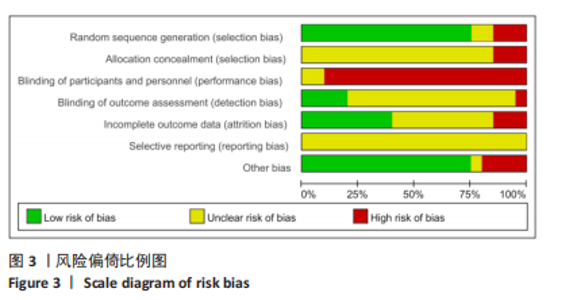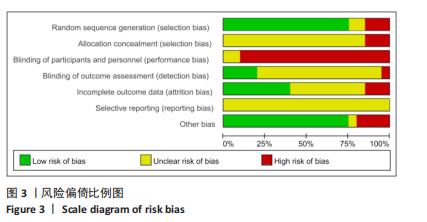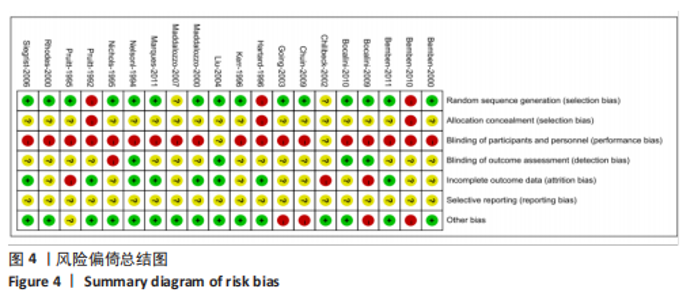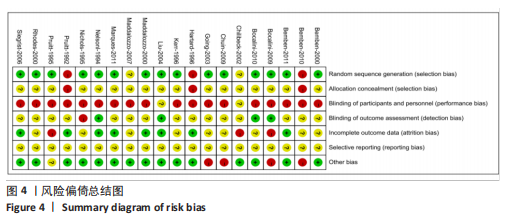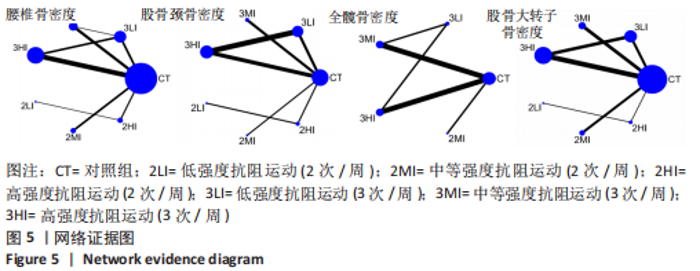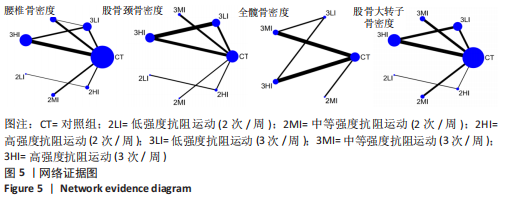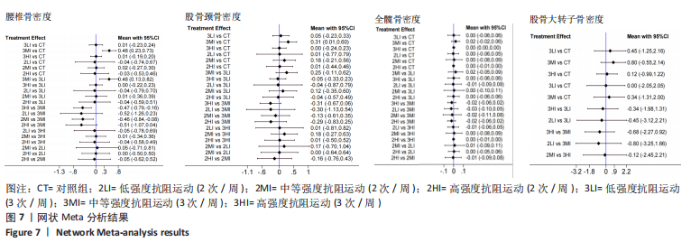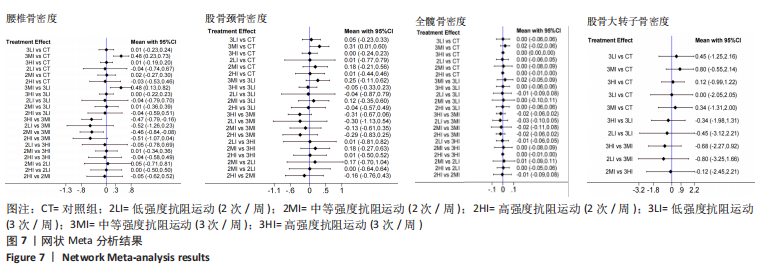Chinese Journal of Tissue Engineering Research ›› 2023, Vol. 27 ›› Issue (28): 4586-4592.doi: 10.12307/2023.571
Effects of different resistance training programs on bone mineral density in postmenopausal women: a network Meta-analysis
Wang Zhenyu1, Xia Yuan1, Lu Yue2, Pan Xinyong1, Li Yongjie3
- 1Wuhan Sports University, Wuhan 430079, Hubei Province, China; 2Hubei Provincial Hospital of Integrated Chinese and Western Medicine, Wuhan 430079, Hubei Province, China; 3Beijing Jishuitan Hospital-Guizhou Hospital, Guiyang 550014, Guizhou Province, China
-
Received:2022-08-02Accepted:2022-10-22Online:2023-10-08Published:2023-01-29 -
Contact:Li Yongjie, Master candidate, Intermediate Rehabilitation Therapist, Beijing Jishuitan Hospital-Guizhou Hospital, Guiyang 550014, Guizhou Province, China -
About author:Wang Zhenyu, Master candidate, Wuhan Sports University, Wuhan 430079, Hubei Province, China -
Supported by:Science and Technology Foundation of Guizhou Provincial Health Commission, No. gzwkj2022-306 (to LYJ)
CLC Number:
Cite this article
Wang Zhenyu, Xia Yuan, Lu Yue, Pan Xinyong, Li Yongjie. Effects of different resistance training programs on bone mineral density in postmenopausal women: a network Meta-analysis[J]. Chinese Journal of Tissue Engineering Research, 2023, 27(28): 4586-4592.
share this article
Add to citation manager EndNote|Reference Manager|ProCite|BibTeX|RefWorks
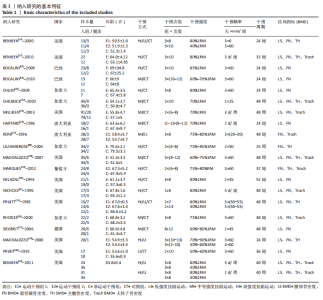
2.2 纳入文献的基本特征 共纳入20项研究,包含1 087例受试者。发表国涉及美国(n=10)、巴西(n=2)、澳大利亚(n=2)、加拿大(n=4)、德国(n=1)以及葡萄牙(n=1)。在干预组中,9项研究涉及高强度-高频抗阻运动(3HI),5项研究涉及中强度-高频抗阻运动(3MI),6项研究涉及低强度-高频抗阻运动(3LI),3项研究涉及高强度-低频抗阻运动(2HI),3项研究涉及中强度-低频抗阻运动(2MI),1项研究涉及低强度-低频抗阻运动(2LI)。结局指标中包含4个部位的骨密度,分别为腰椎(n=17)、股骨颈(n=20)、全髋(n=9)和股骨大转子(n=9)。具体的纳入文献基本特征见表1。"
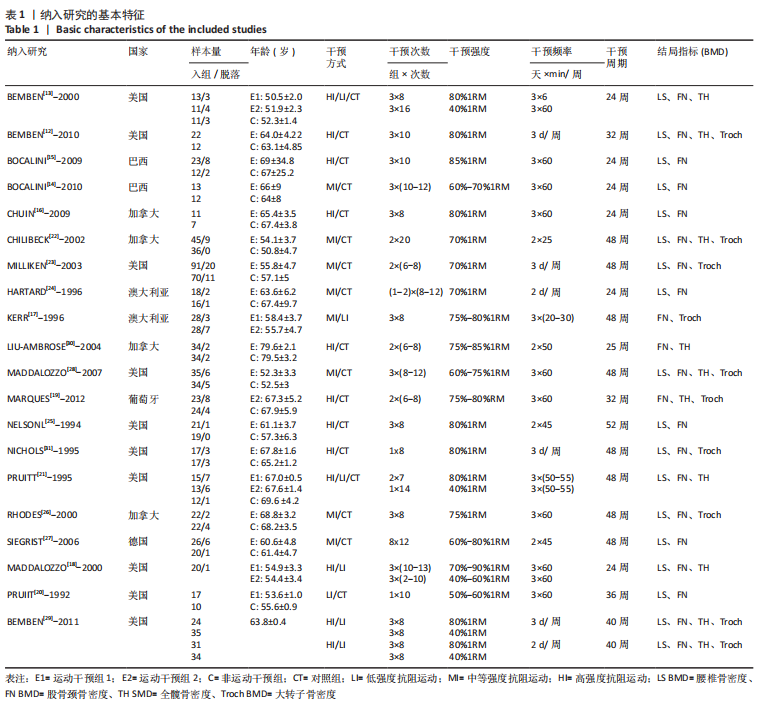
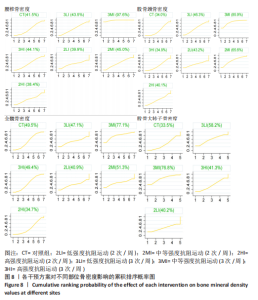
对于腰椎骨密度,与对照组相比,中强度-高频抗阻运动在提高腰椎骨密度方面更优,差异有显著性意义[WMD=0.48,95%CI(0.23,0.73),P < 0.05];此外中强度-高频抗阻运动在提高腰椎骨密度方面也均优于中强度-低频抗阻运动[WMD=-0.46,5%CI(-0.84,-0.08),P < 0.05]、低强度-高频抗阻运动[WMD=0.48,95%CI(0.13,0.82),P < 0.05]、高强度-高频抗阻运动[WMD=-0.47,95%CI(-0.79,-0.16),P < 0.05],这表明中等强度的抗阻运动要好于另外两种强度,且中等强度下的高频训练比低频训练效果要好。 对于股骨颈骨密度,与对照组相比,中强度-高频抗阻运动可有效提高股骨颈骨密度值,差异有显著性意义[WMD=0.31,95%CI(0.01,0.60),P < 0.05];其他各组两两比较,虽然中强度-高频抗阻运动对股骨颈骨密度有明显优势,但差异无显著性意义(P > 0.05)。 对于全髋和股骨大转子骨密度,森林图的两两比较结果显示,虽然中强度-高频抗阻运动较其他干预强度可有效提高全髋和股骨大转子骨密度值,但差异无显著性意义(P > 0.05)。 2.4.4 累计概率排序结果 在腰椎、股骨颈、全髋、股骨大转子骨密度中,干预措施的累计曲线下面积值越高,表明使用该干预方案对提高绝经后女性骨密度越有效。结果显示中强度-高频抗阻运动的锻炼方案在四部位的评分中均为最高,分别为97.36%,85.9%,77.1%,76.8%。提示中等强度一周锻炼3次可能是改善腰椎、股骨颈、全髋、股骨大转子骨密度最好的方式。累计概率排序图如图8所示。"
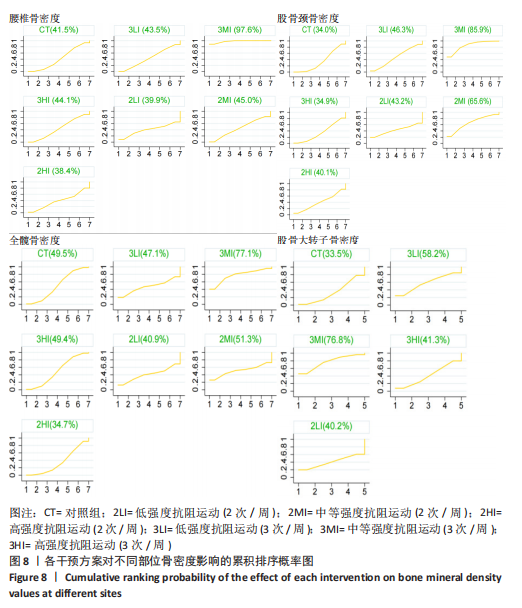
| [1] CHENG C, WENTWORTH K, SHOBACK DM. New Frontiers in Osteoporosis Therapy. Annu Rev Med. 2020;71:277-288. [2] SATHYAPALAN T, AYE M, RIGBY AS, et al. Soy Reduces Bone Turnover Markers in Women During Early Menopause: A Randomized Controlled Trial. J Bone Miner Res. 2017;32(1):157-164. [3] LEVIN VA, JIANG X, KAGAN R. Estrogen therapy for osteoporosis in the modern era. Osteoporos Int. 2018;29(5):1049-1055. [4] JACKSON RD, MYSIW WJ. Insights into the epidemiology of postmenopausal osteoporosis: the Women’s Health Initiative. Semin Reprod Med. 2014;32(6):454-462. [5] REGINSTER JY, BURLET N. Osteoporosis: a still increasing prevalence. Bone. 2006;38(2 Suppl 1): S4-9. [6] CRANDALL CJ, NEWBERRY SJ, DIAMANT A, et al. Comparative effectiveness of pharmacologic treatments to prevent fractures: an updated systematic review. Ann Intern Med. 2014;161(10): 711-723. [7] KOTHAWALA P, BADAMGARAV E, RYU S, et al. Systematic review and meta-analysis of real-world adherence to drug therapy for osteoporosis. Mayo Clin Proc. 2007;82(12):1493-1501. [8] SHEA B, BONAIUTI D, IOVINE R, et al. Cochrane Review on exercise for preventing and treating osteoporosis in postmenopausal women. Eura Medicophys. 2004;40(3):199-209. [9] PALOMBARO KM, BLACK JD, BUCHBINDER R, et al. Effectiveness of exercise for managing osteoporosis in women postmenopause. Phys Ther. 2013;93(8):1021-1025. [10] LE Q, QU Y, TAO Y, et al. Effects of repetitive transcranial magnetic stimulation on hand function recovery and excitability of the motor cortex after stroke: a meta-analysis. Am J Phys Med Rehabil. 2014;93(5):422-430. [11] MAHER CG, SHERRINGTON C, HERBERT RD, et al. Reliability of the PEDro scale for rating quality of randomized controlled trials. Phys Ther. 2003; 83(8):713-721. [12] BEMBEN DA, PALMER IJ, BEMBEN MG, et al. Effects of combined whole-body vibration and resistance training on muscular strength and bone metabolism in postmenopausal women. Bone. 2010;47(3):650-656. [13] BEMBEN DA, FETTERS NL, BEMBEN MG, et al. Musculoskeletal responses to high- and low-intensity resistance training in early postmenopausal women. Med Sci Sports Exerc. 2000;32(11):1949-1957. [14] BOCALINI DS, SERRA AJ, DOS SANTOS L. Moderate resistive training maintains bone mineral density and improves functional fitness in postmenopausal women. J Aging Res. 2010;2010:760818. [15] BOCALINI DS, SERRA AJ, DOS SANTOS L, et al. Strength training preserves the bone mineral density of postmenopausal women without hormone replacement therapy. J Aging Health. 2009;21(3):519-527. [16] CHUIN A, LABONTé M, TESSIER D, et al. Effect of antioxidants combined to resistance training on BMD in elderly women: a pilot study. Osteoporos Int. 2009;20(7):1253-1258. [17] KERR D, MORTON A, DICK I, et al. Exercise effects on bone mass in postmenopausal women are site-specific and load-dependent. J Bone Miner Res. 1996;1(2):218-225. [18] MADDALOZZO GF, SNOW CM. High intensity resistance training: effects on bone in older men and women. Calcif Tissue Int. 2000;66(6):399-404. [19] MARQUES EA, MOTA J, CARVALHO J. Exercise effects on bone mineral density in older adults: a meta-analysis of randomized controlled trials. Age (Dordr). 2012;34(6):1493-1515. [20] PRUITT LA, JACKSON RD, BARTELS RL, et al. Weight-training effects on bone mineral density in early postmenopausal women. J Bone Miner Res. 1992;7(2):179-185. [21] PRUITT LA, TAAFFE DR, MARCUS R. Effects of a one-year high-intensity versus low-intensity resistance training program on bone mineral density in older women. J Bone Miner Res. 1995; 10(11):1788-1795. [22] CHILIBECK PD, DAVISON KS, WHITING SJ, et al. The effect of strength training combined with bisphosphonate (etidronate) therapy on bone mineral, lean tissue, and fat mass in postmenopausal women. Can J Physiol Pharmacol. 2002;80(10):941-950. [23] MILLIKEN LA, GOING SB, HOUTKOOPER LB, et al. Effects of exercise training on bone remodeling, insulin-like growth factors, and bone mineral density in postmenopausal women with and without hormone replacement therapy. Calcif Tissue Int. 2003;72(4):478-484. [24] HARTARD M, HABER P, ILIEVA D, et al. Systematic strength training as a model of therapeutic intervention. A controlled trial in postmenopausal women with osteopenia. Am J Phys Med Rehabil. 1996;75(1):21-28. [25] NELSON ME, FIATARONE MA, MORGANTI CM, et al. Effects of high-intensity strength training on multiple risk factors for osteoporotic fractures. A randomized controlled trial. JAMA. 1994;272(24):1909-1914. [26] RHODES EC, MARTIN AD, TAUNTON JE, et al. Effects of one year of resistance training on the relation between muscular strength and bone density in elderly women. Br J Sports Med. 2000; 34(1):18-22. [27] SIEGRIST CL, JESCHKE D. Strength training using conventional or vibration machines and spinal gymnastics in the prevention of osteoporosis in post-menopausal women. Dtsch Z Sportmed. 2006;57:182-188. [28] MADDALOZZO GF, WIDRICK JJ, CARDINAL BJ, et al. The effects of hormone replacement therapy and resistance training on spine bone mineral density in early postmenopausal women. Bone. 2007;40(5):1244-1251. [29] BEMBEN DA, BEMBEN MG. Dose-response effect of 40 weeks of resistance training on bone mineral density in older adults. Osteoporos Int. 2011;22(1):179-186. [30] LIU-AMBROSE TY, KHAN KM, ENG JJ, et al. Both resistance and agility training increase cortical bone density in 75- to 85-year-old women with low bone mass: a 6-month randomized controlled trial. J Clin Densitom. 2004;7(4):390-398. [31] NICHOLS KP, PETERSON KK. Bone mineral density responses to high-intensity strength training in active older women. Aging Phys. 1995;5(3):26-38. [32] BOROń D, KAMIńSKI A, KOTRYCH D, et al. Polymorphism of vitamin D3 receptor and its relation to mineral bone density in perimenopausal women. Osteoporos Int. 2015; 26(3):1045-1052. [33] DROR AD, VIRK K, LEE K, et al. Resistance Training Threshold for Elevating Bone Mineral Density in Growing Female Rats. Int J Sports Med. 2018; 39(5):382-389. [34] STUNES AK, ERBEN RG, SCHüLER C, et al. Skeletal effects of plyometric exercise and metformin in ovariectomized rats. Bone. 2020;132:115193. [35] 赵忠海,闫彤,李洪秋,等.抗阻训练干预绝经后骨质疏松患者骨密度的系统综述和Meta分析[J].中国组织工程研究,2020,24(30):4914-4920. [36] KISTLER-FISCHBACHER M, WEEKS BK, BECK BR. The effect of exercise intensity on bone in postmenopausal women (part 1): A systematic review. Bone. 2021;143:115696. [37] 阚世锋,陈文华,余波,等.不同运动强度对骨密度影响的研究进展[A].中国康复医学会运动疗法分会第十一届全国康复学术大会,2011. [38] 张林.不同强度运动对骨质疏松大鼠骨生物力学性能的影响[J].体育科学,2000,20(5):72-76. [39] PEARCE G, BASS S, YOUNG N, et al. Does weight-bearing exercise protect against the effects of exercise-induced oligomenorrhea on bone density? Osteoporos Int. 1996;6(6):448-452. [40] VERSCHUEREN SM, ROELANTS M, DELECLUSE C, et al. Effect of 6-month whole body vibration training on hip density, muscle strength, and postural control in postmenopausal women: a randomized controlled pilot study. J Bone Miner Res. 2004;19(3):352-359. [41] STEVEN J, BRYAN SJ, GIULIANO C, et al. Progressive Resistance Training for Concomitant Increases in Muscle Strength and Bone Mineral Density in Older Adults: A Systematic Review and Meta-Analysis. Sports Med. 2022;52(8):1939-1960. [42] 杨则宜.运动营养生物化学研究进展[J].中国运动医学杂志,2004,23(2):158-165+199. [43] BORBA-PINHEIRO CJ, DANTAS EH, VALE RG, et al. Resistance training programs on bone related variables and functional independence of postmenopausal women in pharmacological treatment: A randomized controlled trial. Arch Gerontol Geriatr. 2016;65:36-44. [44] FUCHS RK, BAUER JJ, SNOW CM. Jumping improves hip and lumbar spine bone mass in prepubescent children: a randomized controlled trial. J Bone Miner Res. 2001;16(1):148-156. [45] 丁明晖,黄东锋,李燕,等.运动对骨密度的影响[J].中国骨质疏松杂志,2006,12(1):80-81+88. |
| [1] | Wu Tianliang, Tao Xiuxia, Xu Hongguang. Influence of different bone mineral densities on cage subsidence after stand-alone oblique lateral interbody fusion: three-dimensional finite element analysis [J]. Chinese Journal of Tissue Engineering Research, 2023, 27(9): 1352-1358. |
| [2] | Jiang Xiaocheng, Shi Lu, Wang Yinbin, Li Qiujiang, Xi Chuangzhen, Ma Zefeng, Cai Lijun. Systematical evaluation of bone fusion rate after interbody fusion in patients with osteoporosis and lumbar degenerative disease treated with teriparatide [J]. Chinese Journal of Tissue Engineering Research, 2023, 27(9): 1427-1433. |
| [3] | Ruan Ling, Wang Guanghua, Wu Rongping, Jin Zhan, Lyu Zhenqing, Zhang Nan, Li Shoubang. Correlation between exercise intensity and lipid metabolism disorder and oxidative stress in a high-diet rat model [J]. Chinese Journal of Tissue Engineering Research, 2023, 27(8): 1149-1155. |
| [4] | Li Wenjie, You Aijia, Zhou Junli, Fang Sujuan, Li Chun. Effects of different dressings in the treatment of burn wounds: a network meta-analysis [J]. Chinese Journal of Tissue Engineering Research, 2023, 27(7): 1141-1148. |
| [5] | Liu Hao, Yang Hongsheng, Zeng Zhimou, Wang Liping, Yang Kunhai, Hu Yongrong, Qu Bo. Lumbar MRI vertebral bone quality score to evaluate the severity of osteoporosis in postmenopausal women [J]. Chinese Journal of Tissue Engineering Research, 2023, 27(4): 606-611. |
| [6] | Chen Jianchao, Song Huiping. Distribution characteristics of bone mass in different parts of postmenopausal women with knee osteoarthritis [J]. Chinese Journal of Tissue Engineering Research, 2023, 27(31): 5035-5039. |
| [7] | Gu Peng, Pu Bin, Chen Junbang, Yue Dan, Xin Qiao, Zeng Zhanpeng, Zheng Xiaohui. Correlation between new sarcopenia index and bone mineral density in postmenopausal patients with type 2 diabetes mellitus [J]. Chinese Journal of Tissue Engineering Research, 2023, 27(31): 5009-5014. |
| [8] | Su Hui, Yan Binghan, Wang Ruochong, Xue Haipeng, Tan Guoqing, Xu Zhanwang. Effect of Bushen Zhuanggu Fang on bone metabolism and bone mineral density in rats with ovariectomized osteoporosis [J]. Chinese Journal of Tissue Engineering Research, 2023, 27(28): 4507-4512. |
| [9] | Yin Yikun, Wang Jialin, Sun Junzhi. Therapeutic effect of different-frequency repetitive transcranial magnetic stimulations on post-stroke cognitive impairment: a Meta-analysis [J]. Chinese Journal of Tissue Engineering Research, 2023, 27(20): 3274-3280. |
| [10] | Jiang Guozheng, Feng Ningning, Yu Xing, Zhao He, Yang Yongdong, Qu Yi, Wang Fengxian. Correlation between hand feeling and torque of screw insertion in lumbar pedicle system [J]. Chinese Journal of Tissue Engineering Research, 2023, 27(18): 2861-2865. |
| [11] | Peng Tuanhui, Yang Ling, Ding Xiaoge, Meng Pengjun. A systematic review and meta-analysis of the effects of long-term exercise on blood lipids in healthy elderly people [J]. Chinese Journal of Tissue Engineering Research, 2023, 27(14): 2276-2282. |
| [12] | Yin Yuping, Liu Jiachen, Guo Ningning, Li Chuangquan, Liu Xiuwen, Zhang Shukang, Lin Xueqing, Tang Wei, Chen Shaoxiong, Liu Xingguang, Wu Guixia, Li Long, Liu Jing, Zhang Hong. Bone mineral density difference in bilateral femoral necks measured by dual-energy X-ray absorptiometry and its influencing factors [J]. Chinese Journal of Tissue Engineering Research, 2023, 27(13): 2081-2086. |
| [13] | Jing Jinpeng, Zhang Yue, Liu Xiaomin, Liu Yi. Traditional Chinese medicine injection for promoting blood circulation in prevention of deep vein thrombosis after orthopedic surgery: network meta-analysis [J]. Chinese Journal of Tissue Engineering Research, 2022, 26(9): 1467-1476. |
| [14] | Gu Zhengqiu, Xu Fei, Wei Jia, Zou Yongdi, Wang Xiaolu, Li Yongming. Exploratory study on talk test as a measure of intensity in blood flow restriction training [J]. Chinese Journal of Tissue Engineering Research, 2022, 26(8): 1154-1159. |
| [15] | Liu Gang, Ma Chao, Wang Le, Zeng Jie, Jiao Yong, Zhao Yi, Ren Jingpei, Hu Chuanyu, Xu Lin, Mu Xiaohong. Ankle-foot orthoses improve motor function of children with cerebral palsy: a Meta-analysis based on 12 randomized controlled trials [J]. Chinese Journal of Tissue Engineering Research, 2022, 26(8): 1299-1304. |
| Viewed | ||||||
|
Full text |
|
|||||
|
Abstract |
|
|||||
